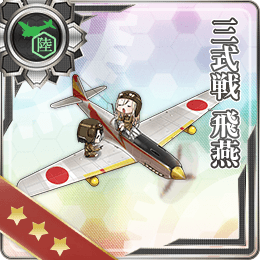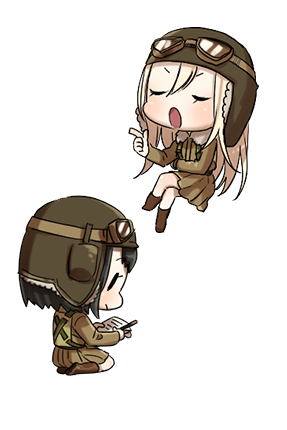[Edit]
Type 3 Fighter Hien
Type 3 Fighter Flying Swallow
No.176 三式戦 飛燕
| |
| Refittable Class | |
| Coastal Defense Ship | Destroyer |
| Light Cruiser | Torpedo Cruiser |
| Heavy Cruiser | Training Cruiser |
| Aviation Cruiser | Fast Battleship |
| Battleship | Aviation Battleship |
| Light Carrier | Standard Aircraft Carrier |
| Armored Carrier | Seaplane Tender |
| Submarine | Aircraft Carrying Submarine |
| Submarine Tender | Fleet Oiler |
| Repair Ship | Amphibious Assault Ship |
Introduction
かの国で開発された液冷エンジンを参考に開発された、液冷エンジンを装備した陸軍戦闘機、三式戦「飛燕」です。残念ながら信頼性に難があり、その実力を十分に発揮できませんでしたが、万全な状態であれば高い潜在力を持っています。
Developed using the liquid cooled engine developed in that country as a reference, this is an army fighter equipped with a liquid cooled engine, the Type 3 Fighter "Hien". Unfortunately there were problems with the reliability and it was unable to exert its full potential, but in ideal conditions it has lots of potential.
Notes
Unbuildable
Reward for Spring 2016 Event E-4 Hard, E-5 Easy and Normal; Summer 2016 Event E-2 Normal; and Fall 2016 Event E-1 Easy.
History
The Kawasaki Ki-61 Hien is a Japanese World War II fighter aircraft used by the Imperial Japanese Army Air Service. The Japanese Army designation was "Army Type 3 Fighter" (三式戦闘機 "Sanshiki sentouki").It was the only mass-produced Japanese fighter of the war to use a liquid-cooled inline V engine. Over 3,000 Hiens were produced. Initial prototypes saw action over Yokohama during the Doolittle Raid on 18 April 1942, and continued to fly combat missions throughout the war.
The Development of the Hien started with the Ki-28 after failing to win a bid against Nakajima's Ki-27. Committed to keep developing aircraft, Kawasaki turned its attention to obtaining a production license from Daimler-Benz to manufacture the DB 600 and DB 601 engines in Japan hoping that the Army would be interested in developing new designs to exploit the power plant and by March 1938 the production licenses were secured. In February 1940, drawing on doctrinal lessons learned from the aerial combat during the Nomonhan Incident with the Soviet Union, the Army issued a requirement for Kawasaki to built a prototype experimental heavily armed fighter, which would become the Ki-60, and a "lighter" general-purpose experimental fighter, which would become the Hien. The design of the Ki-60 was to emphasize speed, dive and climb performance, whilst the Hien was planned to deliver more general-purpose offensive capabilities required for the recently established doctrine of "aerial exterminating action". In April 1940, Kawasaki obtained the rights to manufacture the the latest version of the Daimler-Benz engine, the DB 601A, with blueprints and pattern engines arriving from Germany that same year. The first Kawasaki-built DB 601A, designated as Ha-40, was available from July 1941, and by November it had passed all ground-running tests. Kawasaki, however struggled with the responsibility of developing both the home-manufactured engine and the airframe design that it was intended to power. This resulted in a lengthy delay in the fighter's introduction to service. The Ha-40 inverted-V engine that would power the Hien was slightly lighter than the DB 601, but more powerful. Kawasaki had been unsuccessful in gaining licence manufacturing rights for the DB 601’s all-important Bosch fuel injection system, so it had to incorporate a Mitsubishi-designed alternative instead. This proved effective enough, but in frontline service various engine-related problems with the Hien, which were magnified in the unforgiving environments to which it was deployed, were to ultimately blight the aircraft’s operational record.
The all-metal, semi-monocoque fuselage was basically oval in cross-section, changing to a tapered, semi-triangular oval behind the cockpit canopy, with a maximum depth of 1.35 m (4 ft 5 in). An unusual feature of the Hien was that the engine bearers were constructed as an integral part of the forward fuselage, with the cowling side panels being fixed. For servicing or replacement, only the top and bottom cowling panels could be removed. A tapered, rectangular supercharger air intake was located on the port-side cowling. Behind the engine bulkhead were the ammunition boxes feeding a pair of synchronized 12.7 mm Ho-103 machine guns which were set in a "staggered" configuration in a bay just above and behind the engine. The breeches partly projected into the cockpit, above the instrument panel. The Ho-103 was a light weapon for its caliber and fired a light shell, but this was compensated for by its rapid rate of fire. The ammunition capacity was limited, having only around 250 rounds for each weapon. A self-sealing fuel tank with a capacity of 165 L was located behind the pilot's seat. The windshield was armored and there was a 13 mm armor plate behind the pilot. The radiator and oil cooler for the liquid-cooled engine were in a ventral location below the fuselage and wing trailing edge, covered by a rectangular section fairing with a large, adjustable exit flap.
The Type 3 Fighter, Model I A had a fully retractable tail wheel, two 7.7 mm Type 89 machine guns in the wings and two synchronized 12.7 mm Ho-103 machine guns in the forward decking. Capable of carrying one 151 L drop tank or a light bomb. The B variant saw that the tail wheel retraction mechanism was unreliable, thus the aircraft was modified accordingly, while Two 12.7 mm Ho-103 machine guns replaced the wing 7.7 mm machine guns.The C variant was built in conjunction with the B variant, the wing machine guns were replaced by Mauser MG 151/20 cannons. Each upgrade in the armament of the Hien caused its performance and agility to suffer, but it remained capable of reaching a maximum speed of 580 km/h.
Trivia
- The plane shown above is a Type 3 Fighter, Model I B and the color scheme of the in-game artwork is based off that of the 149th Shinbu-tai, part of the 59th Squadron stationed at Ashiya Airfield, Fukuoka Prefecture.[1]
- The Hien received the code name "Mike" assuming it was a German fighter, later it was assumed it was of Italian origin thus it was renamed "Tony".
- Originally it was assumed to be a license-built Messerschmitt Bf 109, but later it was thought to be a Macchi C.202.
- The some members of the 68th Squadron called the aircraft "Roku-ichi" (六一 "six-one") instead of "Hien" or "Ki-61".
- Early versions of the Hien had a higher loaded weight (2950 kg) than the prototypes of the Ki-60 (2750 kg).
- The very high pressure of the Mitsubishi fuel injection system led to fuel leakage and fuel line ruptures, problems with the ignition system, poor quality spark plugs causing pre-ignition or constant fouling, leaks in the coolant system due to poor castings which caused overheating and the quality of bearings caused many failures. Combined with the lack of experience of the maintenance crews with liquid-cooled engines, insufficient numbers of mechanics, inadequate maintenance facilities, lack of spare parts and adverse weather conditions, and this, combined with the number of aircraft available, ultimately proved crippling for the Hien.
- On 18 April 1942 during the Doolittle Raid on Tokyo, the Hien made its debut as Major Yoshitsugu Aramaki (荒蒔儀次陸軍少将) and Warrant Officer Ryozaburo Umekawa (梅川亮三郎准尉) of the Flight Test Center had been flying the second and third Ki-61 prototypes in gunnery trials from Mito airfield when they were alerted to the raid. Through binoculars, they spotted a medium-sized aircraft with stars on its wings at an altitude of about 650 ft, and both pilots immediately decided to take off in an attempt to intercept it. However, the armorer officer, Captian Hashimoto, warned them that the two Hien prototypes were only loaded with practice ammunition of a non-explosive type, and he would need about 30 minutes to re-arm the aircraft with explosive rounds. Aramaki, therefore, decided to send Umekawa off first with the practice ammunition and then follow on in another prototype after it had been re-armed with the explosive rounds. After takeoff Umekawa encountered a B-25B Mitchell over Kasumigaura heading south at an altitude of about 1000 ft, and he made his first gunnery pass as the enemy aircraft crossed the coastline. Evading return fire from the bomber’s gun turret, he completed a second and third pass, noting that the gunner had ceased firing. His fire had hit the bomber near the wing root and he saw oil or fuel streaming back. Umekawa wanted to continue his attack, but by that stage his fuel was low and he decided to break off and return to base, rather than risk damaging the valuable prototype in a forced landing. Aramaki took off from Mito in the other prototype once it had been re-armed, setting off in pursuit of the B-25s. However, Zero fighters of the Japanese Navy's Yokosuka Air Group spotted his unfamiliar fighter and prepared to attack it. The Japanese military was aware of the impending carrier strike and had called its air defenses to readiness, but it was presumed that the raid would occur a day later on 19 April as the carrier would need to approach closer to the mainland to launch its fighters. Therefore, there was an expectation of encountering enemy fighters. As the Zeros came in to attack his Hien, Aramaki banked sharply to display the Japanese Hinomaru on his wings and waggled them to prevent a friendly fire incident. After this encounter he could not locate any enemy bombers and returned to base without engaging.
- During the raid, WO Umekawa made his first pass against Lt. Everett W. Holstrom's B-25 (40-2282), while his second and third pass were against Capt. C. Ross Greening's B-25 (40-2249, aka "Hari Kari-er"). He didn't notice when he exchanged targets.
- Greening's exact statement to the USAAF was that they had come under "sustained attack" by four aircraft of unknown type, described as ‘new model fighters closely resembling Zeros except for their inline engines’ with six machine guns in the wings.
- The Hien first official deployment was with the 68th and 78th Squadrons in Boram Airfield, Wewak, New Guinea.
- Taiyou carried the first elements of the 68th Squadron form Yokosuka to Truk as cargo, which arrived on 10 April. On their flight from Truk to Rabaul on 25 April 1943 bad weather struck and the group returned to Truk, Sargent Major Shoichi Ohki was lost. Two days later two groups of 13 and 14 Hiens each sortied again. The first group of 13 lost 10 of its planes, while the second group managed to arrive safely at Vunakanau. On 3 May a second ferry flight was attempted, but more aircraft were lost in the process.
- Due to these disasters the remaining 68th Squadron members and the 78th Squadron were ferried in a more safe, but longer route.
- The IJNAF's 751st Air Group (a Mitsubishi G4M unit) stationed in Vunakanau , were the first members of the Navy to see the Hien and were curious about the new army fighter.
- Both units were destroyed by Allied forces in New Guinea and surviving ground and aircrew were used as infantry with few survivors.
- Taiyou carried the first elements of the 68th Squadron form Yokosuka to Truk as cargo, which arrived on 10 April. On their flight from Truk to Rabaul on 25 April 1943 bad weather struck and the group returned to Truk, Sargent Major Shoichi Ohki was lost. Two days later two groups of 13 and 14 Hiens each sortied again. The first group of 13 lost 10 of its planes, while the second group managed to arrive safely at Vunakanau. On 3 May a second ferry flight was attempted, but more aircraft were lost in the process.
- The Hien, and the Japanese Navy's Suisei, Serian and Nanzan shared the same base design engine (the Daimler-Benz DB 601A). The Army operated Kawasaki's Ha-40, while the Navy operated the Aichi's Atsuta engine.
References
- ↑ File:Ki-61 at Fukuoka in 1945.jpeg. (2014, November 8). Wikimedia Commons, the free media repository. Retrieved 03:21, June 24, 2017 from https://commons.wikimedia.org/w/index.php?title=File:Ki-61_at_Fukuoka_in_1945.jpeg&oldid=138967225.
See also
Additional Ki-61 reading material




